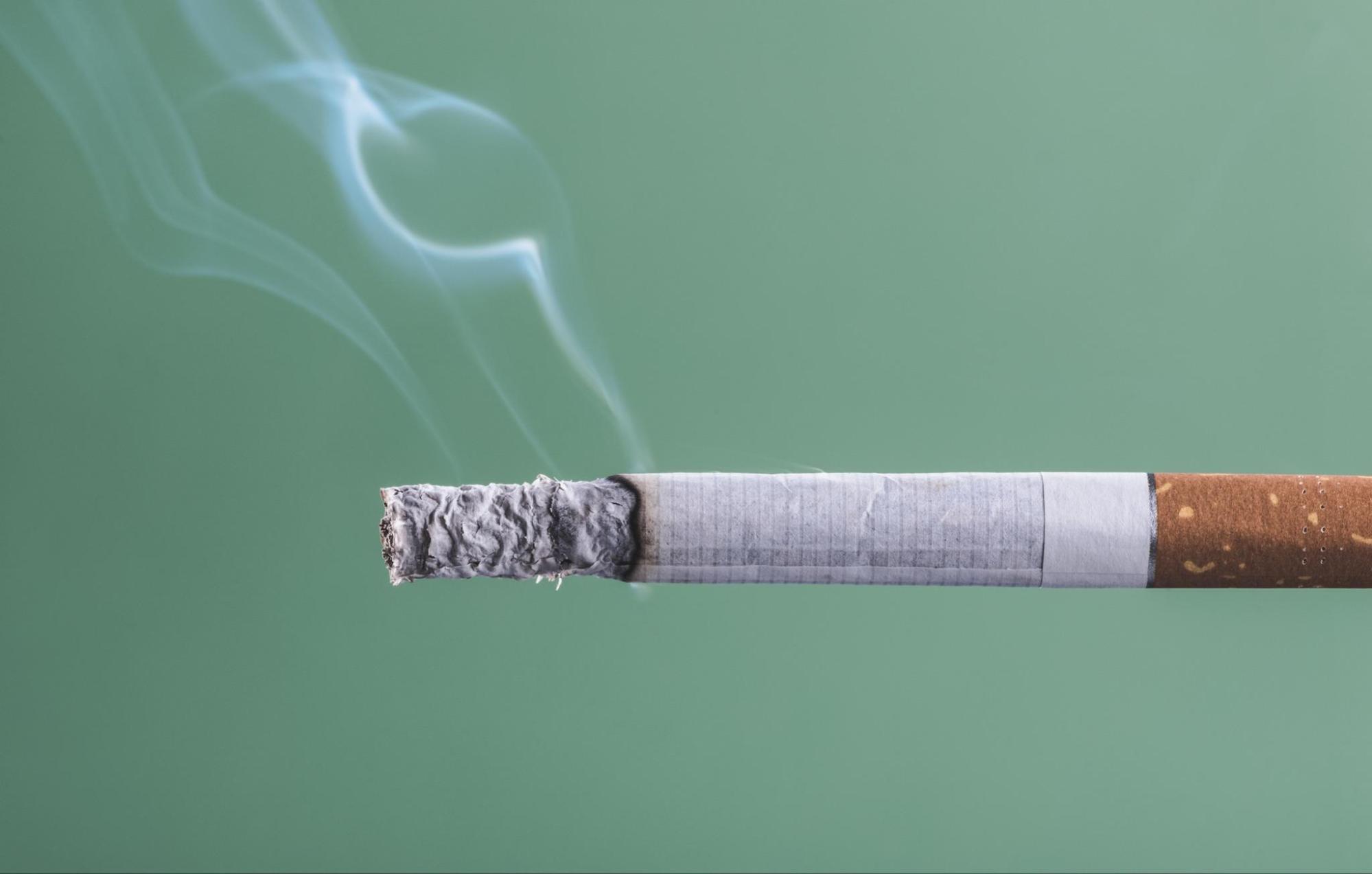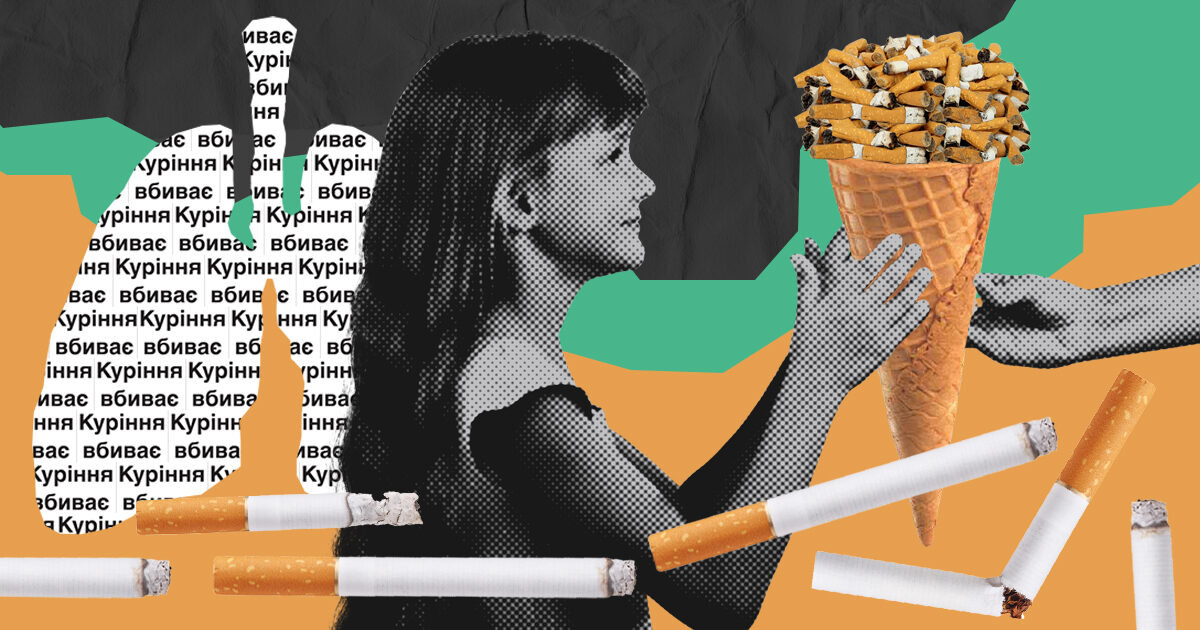
Rubryka learned about why the tobacco industry is interested in teenagers, what myths it cultivates, and why the smoking problem remains relevant even amid a full-scale war.
"I was in the fourth grade. Summer. I started smoking"
Personal habits are personal choices. But when it comes to addiction, it's another matter. Especially when it violates the personal boundaries of others. We don't see 80% of tobacco smoke. Meanwhile, it settles on the furniture and clothes of the smoker and those nearby. And it gradually poisons the body.
Despite the full-scale war, Ukrainians continue to die not only from missiles. Every year about 13,000 citizens of Ukraine who are not smokers die from diseases caused by passive smoking.
According to estimates by the World Health Organization, one in two teenagers aged 13 to 15 tried smoking at least once.
But many children start smoking even earlier.

Maksym is now 24. The guy is in good physical shape, quickly climbs the stairs to his 16th floor, and doesn't tolerate tobacco smoke. When friends light a cigarette or reach for a vape, Maksym automatically takes a few steps back: he chokes on a cough. He is also an ex-smoker. Smiling, the guy proudly says he quit smoking in the fifth grade.
"I was in the fourth grade. Summer. I started smoking. I hang out with a group of people 4–6 years older than me. They played with cigarettes and somehow let me try. I still remember how I coughed then. But in the end, that's how I started smoking."
In the early 2000s, tobacco advertising in Ukraine flourished. It was not regulated by legislation: it was on television, in magazines, on billboards, etc. Many people even wore caps or bags with the logos of tobacco companies, which came into widespread use in the 90s.

Even quite recently—in 2019—such cigarette advertisements could be seen on the streets of Kyiv. It was another attempt to promote tobacco brand advertising under the guise of another product, which the State Food and Beverage Service quickly stopped.
Brands actively worked on the myth that cigarettes are an attribute of adult life and serious people. So even in young children's friend circles, trying to smoke was considered very adult. Actually, not much has changed in this sense since that time.
"At that time, everyone in this friend group believed that you would get lip cancer if you did not inhale the smoke. But at first, I couldn't inhale and went to bed thinking I had cancer. And the next day, I went to smoke again. It's funny to think about it now," says Maksym.
Cigarettes were bought by the oldest of the group, seventeen-year-olds. Then you could buy them by the piece from people selling cigarettes just down the road. The children kept the purchase in a tire near a garage. After smoking, they plucked the neighbor's mint or lemon balm: they rubbed some of it on their hands and clothes and chewed some to get rid of the smell.
"Usually, we all raised money for cigarettes. When there was no money, we smoked paper. You set the paper on fire, smoke comes out, and you smoke. We smoked other people's butts but lit them on both sides to avoid catching anything. We picked up cigarette butts for our parents. Or we shared a cigarette with two, three, or four people.
At the same time, we played sports, went to horizontal bars, and played football. We were all active children. When I went out with another friend circle where no one smoked, I didn't smoke either. Then the holidays ended, school started, and I stopped smoking. It wasn't difficult," concludes Maksym. And then he adds that at 16, he took up cigarettes again.
Substitution of concepts and invention of statuses: what does tobacco industry do
Although tobacco advertising has been banned in Ukraine since 2012, as of 2022, the industry uses several hidden advertising tools and marketing ploys. According to the WHO, $23 million is spent daily on tobacco campaigns in the United States. Instead, in Ukraine, tobacco companies have spent $200 million over the past few years to attract children and young people to heated cigarettes and devices for them. But what exactly did they invest in?
Cigarette pack design. According to official requirements, each pack must have a text and graphic warning about the dangers of smoking. Together, they occupy 50% of the packaging area. Often, in shops and kiosks, this part is covered with price tags. The remaining 50% is a stylish design that attracts and creates the illusion of something prestigious.
According to the 1978-IX law, from January 11, 2024, such warnings must occupy 65% of the area of the pack. As Canada's experience shows, after a similar decision, the smoking rate in the country decreased from 4.6% to 2.9%.
Another significant expense is a cigarette display. Large windows with bright lighting and colorful cigarette packs especially attract the attention of children and teenagers. Such stalls can often be seen near schools. Children and adolescents who see bright display windows of street furniture displaying cigarettes have a 60% greater risk of becoming smokers.
According to Johns Hopkins University research, Kyiv has four tobacco sales points within walking distance (250 meters around the school) for each school. Thus, children who see cigarettes displayed in store windows are 64% more likely to start smoking, and 38% of adult smokers trying to quit smoking agree that tobacco products in store windows cause a spontaneous desire to smoke.
The third point of the main expenses is the creation of a myth that devices for heated tobacco like IQOS are completely safe gadgets and just part of the style, and not another variation of a dangerous habit. To do this, manufacturers launch collaborations with celebrities and use the entire spectrum of advertising services because the new norm, which prohibits the advertising of devices for heated tobacco on the same level as ordinary cigarettes, will come into force only in the middle of 2023. Meanwhile, stylish commercials, bright billboards, and Instagrams of celebrities, who are adored by a minor audience, broadcast that IQOS, Glo, and other similar devices are stylish gadgets that are not associated with health threats.
In addition, tobacco manufacturers are constantly releasing new products with different flavors and aromas. This, in turn, is an additional tool for attracting children. Manufacturers, in fact, "sweeten the poison" and do it under the slogans from the advertisements mentioned above.
The myths cultivated by the tobacco industry are designed to turn as many people as possible into smokers; that's how the industry makes money. One of the target audiences of tobacco product manufacturers is youth and teenagers.

How to fight it?
Dmytro Polonskyi, a communication manager of the Zhyttia public organization, explains that inculcating the habit of smoking in minors is one of the tasks the tobacco industry sets. Adult smokers die early. Reaching teenagers, lest it sounds boring, is difficult.
"Why do arguments work badly in such cases? In short, advertising is bright, attractive, and beautiful, while explanations are dull and uninteresting to teenagers.
The tobacco industry attracts the attention of minors in different ways. Cigarette showcases plus standardized packaging have been used for a long time in many countries. But due to the industry's opposition, such seemingly simple things as banning shop windows have yet to be adopted in Ukraine. It is they who attract children to smoking. Also, there is still advertising and promotion of the sale of tobacco products, electronic cigarettes, and their liquids, and the sale of cigarettes with flavors and aromas (for example, fruits, berries, or sweets), but thanks to the law No. 1978 from July 11, 2023, this will be prohibited," says Dmytro Polonskyi.
Indeed, the mentioned draft law was approved in December 2021. Before this, heated tobacco products such as Iqos were not mentioned in the legislation in any way. Now the situation has changed.
In July 2022, a ban on smoking not only ordinary cigarettes but also the already mentioned Iqos and vapes came into force. In addition, the draft law:
- gives local self-government bodies the right to define additional places free of smoking;
- provides for health warnings on smokeless tobacco products (sticks/hits for IQOS, Glo devices) and on electronic cigarettes, liquids, and containers;
- defines and regulates HTPs (heated tobacco products) as tobacco products;
- prohibits the sale of HTPs to minors;
- prohibits advertising, sales promotion, and sponsorship of electronic cigarettes, liquids, refill containers, and devices for consumption of tobacco products without burning them (including IQOS, Glo);
- prohibits cigarettes and tobacco for rolling paper, electronic cigarettes, liquids, and refill containers with a characteristic taste and aroma (menthol, fruits, sweets, etc.);
- introduces requirements and technical specifications for electronic cigarettes and liquids, refueling containers;
- introduces combined (picture + text) health warnings at 65% of the pack size of smoking tobacco products.

Smuggling myth
World practice shows that one of the most effective ways to combat smoking at the state level is to increase the excise tax. Cigarette manufacturers stubbornly propagate the point that such a decision will facilitate smuggling.
Meaning people will look for where to find cigarettes cheaper and start buying them from illegal producers, accepting lower quality. Meanwhile, the country will not receive taxes. However, experts call this point manipulative and false. This is another myth that the tobacco industry is trying to dispel to keep its profits and increase the number of smokers worldwide.
"Smuggling is a myth. There are practically no 'contraband' cigarettes in Ukraine. The absolute majority represented on the illegal market are cigarettes produced in legal factories and released on the market with tax evasion. Illegal trade in excise goods has increased significantly since the beginning of the year, but for some reason, law enforcement officers do not pay much attention to it.
On December 7, 2017, the Verkhovna Rada of Ukraine [Ukrainian parliament, ed.] supported the plan to increase excise taxes on tobacco products during 2018–2025. By 2025, tobacco excise will grow by at least 20% annually. However, the plan to increase excise taxes for 2018–2025 does not consider inflation and the growth of the population's income. For cigarette taxes and prices to reach the minimum European level, in addition to the 20% annual increase in excise duties, it is also necessary to increase excise duties to the level of inflation.
The industry intervenes in forming excise policy with the help of tobacco lobbyists in state authorities and through commissioned, manipulative, paid publications in the mass media to prevent the increase of excise rates on tobacco products," Dmytro Polonskyi, communication manager of the Zhyttia public organization explains.
Various tactics are used to prevent the increase of tobacco taxes: intimidation by the growth of illegal trade, underestimation of budget revenues due to the accumulation of tobacco products in warehouses on the eve of the increase in excise taxes—forestalling—and sale through the shadow market of products intended for duty-free shops. It is worth noting that such actions are directly contrary to Article 5.3 and Article 12 of the WHO and the Guidelines for its application, as well as Art. 4 of the Law of Ukraine "On measures to prevent and reduce the use of tobacco products and their harmful effects on the health of the population."
The tobacco industry is resisting pressure from activists. However, the first shifts are already there. And the results from them can be seen very soon.
Newsletter
Digest of the most interesting news: just about the main thing






